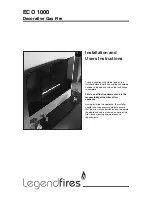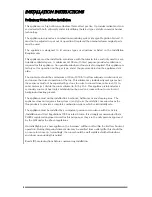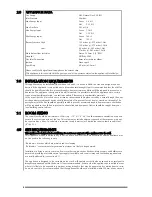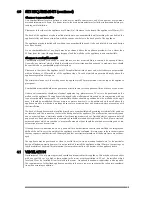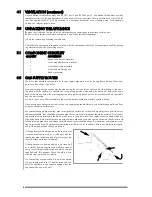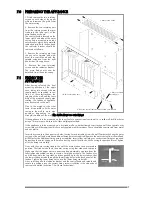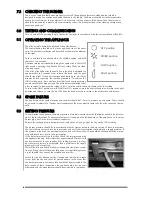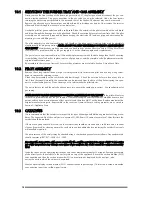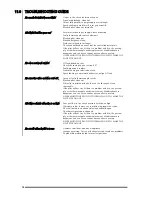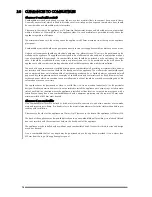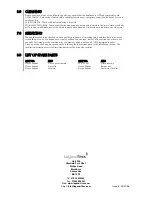
5
SSIITTEE R
REEQ
QU
UIIR
REEM
MEEN
NTTSS ((ccoonnttiinnuueedd))
C
Clleeaarraanncceess ttoo nnoonn-ccoom
mbbuussttiibblleess
Non combustible surfaces are defined as brick, metal, marble, concrete etc. and also a number of man-made
materials impervious to flame. If in doubt refer to the material manufacturer for further information before pro-
ceeding with installation.
Clearances to the sides of the appliance are 50mm (2in). Clearance to the front of the appliance is 500mm (2ft).
The back of the appliance may be installed directly onto a non-combustible wall, providing the area behind the
appliance is flat and does not interfere with the various vent holes in the back panel of the appliance.
The appliance may be installed with or without a non combustible hearth. If a hearth is fitted, the size and design
may be as desired.
A non combustible shelf of any depth may be positioned above the appliance provided it is no closer than
400mm from the top of the appliance glass panel and the wall above the appliance is non combustible.
C
Clleeaarraanncceess ttoo ccoom
mbbuussttiibbllee m
maatteerriiaallss
Combustible materials are defined as wood, fabrics, or other materials likely to combust if exposed to flame.
Generally, any material, which is likely to discolour, melt or misshape when exposed to moderate heat, should
be considered as a combustible material or surface.
Clearance to the sides of the appliance are 100mm(4in) but curtains, drapes and other fabrics are not permitted
within a distance of 500mm(20in) of the appliance sides. No such materials are permitted directly above the
appliance regardless of distance.
The minimum clearance to the ceiling above the appliance is 800mm measured from the top of the appliance
glass panel.
Combustible materials should not be positioned directly in front of the appliance within a distance of one metre.
Under no circumstances should any electrical equipment e.g. plasma screen TV sets etc. be positioned on the
wall above the appliance. The appliance is designed to be wall mounted alone and not in conjunction with any
type of combustible fire surround. No combustible shelves should be positioned on the wall above the appli-
ance. It should be established that any mirrors or picture frames etc. to be positioned on the wall above the
appliance are able to withstand prolonged exposure to moderate heat and moisture before proceeding with
their installation.
The back of the appliance may be installed directly onto a combustible wall, providing it is relatively flat and does
not interfere with the various vent holes in the back panel of the appliance. The wall must be structurally sound
and constructed from a material capable of withstanding moderate heat. Finished plaster, conventional wall
paper and dry-lined plasterboard are examples of suitable materials. Materials such as flock, blown vinyl and
embossed paper which are sensitive to even small amounts of heat should be avoided as scorching and or dis-
colouration may occur over time.
If the appliance is to be mounted on a dry lined wall or a timber framed construction wall then the integrity and
ability of the wall to carry the weight of the appliance must be confirmed. It is important in these circumstances
that any vapour control barrier is not damaged, and that any structural members of the house frame are not dam-
aged.
The appliance may be positioned as close to a solid floor (i.e. stone, wooden laminate etc.) as the particular
design of fireframe permits, however it is not permitted to install the appliance within 100mm of carpet, rugs or
fabric materials of any kind. This dimension is measured vertically to the bottom of the appliance frame.
V
VEEN
NTTIILLA
ATTIIO
ON
N
A minimum of 100 cm
2
purpose provided ventilation is required for this appliance. This may be achieved either
with one vent 100 cm
2
at a high or low position in the room, or split ventilation i.e. 50cm
2
be installed at high
level and 50cm
2
be installed at low level within the room. An openable window or equivalent is also required.
The requirements of other flued appliance operating in the same room or space must be taken into considera-
tion when assessing ventilation.
44..00
44..11

